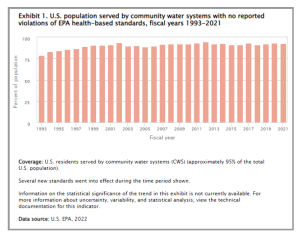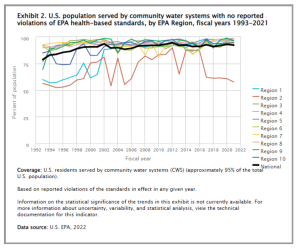3.4 Water Pollution Trends and Control
Trends in the US
In the 1960s, some rivers in the US carried so much pollution that it was possible for them to be on fire. Many of the industrial wastes in water of that period have been significantly reduced, but a constant stream of new chemicals, many of them persistent in the environment and difficult to treat, is being produced, and some kinds of wastes, such as heavy metals, continue to be a problem. Clean-up is further complicated because, for many pollutants, no safe levels exist – to render drinking water safe and to protect water quality in rivers and lakes to protect aquatic ecosystems, these materials should be entirely removed, which is likely impossible.
Under the Clean Water Act of 1972, pollutant means “dredged spoil, solid waste, incinerator residue, sewage, garbage, sewage sludge, munitions, chemical wastes, biological materials, radioactive materials, heat, wrecked or discarded equipment, rock, sand, cellar dirt and industrial, municipal, and agricultural waste discharged into water.” Such a comprehensive definition makes for challenging enforcement.
Drinking Water
The USEPA is charged with enforcing most US water-quality laws. The agency issues an annual Report on the Environment that provides information on aspects of air quality, water quality, land, condition, human health, and ecological condition. The following information is from the 2022 report section on drinking water.
Community water systems (CWS) are public water systems that supply water to the same population year-round. In fiscal year (FY) 2021, more than 315 million Americans (U.S. EPA, 2021)—roughly 95 percent of the U.S. population (U.S. Census Bureau, 2021)—got at least some of their drinking water from a CWS. This indicator [the EPA indicator for drinking water] presents the percentage of Americans served by CWS for which states reported no violations of EPA health-based standards for more than 90 contaminants (U.S. EPA, 2022a).
Health-based standards include Maximum Contaminant Levels (MCLs), Maximum Residual Disinfection Levels (MRDLs), and Treatment Techniques (TTs). An MCL is the highest level of a contaminant that is allowed in drinking water. An MRDL is the highest level of a disinfectant allowed in drinking water (U.S. EPA, 2022c). A TT is an enforceable procedure or level of technological performance which public water systems must follow to ensure control of a contaminant (U.S. EPA, 2022b). TTs are adopted where it is not economically or technologically feasible to ascertain the level of a contaminant, such as microbes, where even single organisms that occur unpredictably or episodically can cause adverse health effects. Compliance with TTs may require a variety of actions to protect public health, such as assessment of the system, filtration and disinfection, and optimized corrosion control (U.S. EPA, 2022b).
This indicator tracks the population served by CWS for which no violations of health-based standards were reported to EPA annually for the period from FY 1993 to FY 2021, the latest year for which data are available. Results are reported as a percentage of the overall population served by CWS, both nationally and by EPA Region. This indicator also reports the number of persons served by systems with reported violations of standards covering surface water treatment, microbial contaminants (microorganisms that can cause disease), disinfection byproducts (chemicals that may form when disinfectants, such as chlorine, react with naturally occurring materials in water and may pose health risks), and other contaminants. The indicator is based on violations reported quarterly by EPA, states, territories, and the Navajo Nation, who each review monitoring results for the CWS that they oversee.
Of the population served by CWS nationally, the percentage served by systems for which no health-based violations were reported for the entire year increased overall from 79 percent in 1993 to 92 percent in FY 2021 (Fig 1). Drinking water regulations have changed in recent years. This indicator is based on reported violations of the standards in effect in any given year.
When results are broken down by EPA Region, some variability over time is evident (Fig 2). Between FY 1998 and FY 2021, most Regions were consistently above the national percentage. Only Region 2 remained consistently below the national percentage over the entire period of record, largely because of a small number of public water systems serving large populations.
In FY 2021, reported violations involving surface water treatment rules were responsible for exceeding health-based standards for 15.6 million people (4.9 percent of the population served by CWS nationally). Reported violations of the health-based disinfection byproducts rules affected 4.3 million people (1.4 percent of the CWS-served population).


Type your examples here.
- First
- Second
“The term “pollutant” means dredged spoil, solid waste, incinerator residue, sewage, garbage, sewage sludge, munitions, chemical wastes, biological materials, radioactive materials, heat, wrecked or discarded equipment, rock, sand, cellar dirt and industrial, municipal, and agricultural waste discharged into water.”
https://www.epa.gov/cwa-404/clean-water-act-section-502-general-definitions#
https://www.pca.state.mn.us/air-water-land-climate/water-pollutants
Consider using the classes at https://en.wikipedia.org/wiki/Water_pollution
Read up on https://en.wikipedia.org/wiki/Clean_Water_Act before starting the categories.
“The term “pollutant” means dredged spoil, solid waste, incinerator residue, sewage, garbage, sewage sludge, munitions, chemical wastes, biological materials, radioactive materials, heat, wrecked or discarded equipment, rock, sand, cellar dirt and industrial, municipal, and agricultural waste discharged into water.”
https://www.epa.gov/cwa-404/clean-water-act-section-502-general-definitions#
https://19january2021snapshot.epa.gov/report-environment/sustainability-and-roe_.html – why is sustainability in the EPA Report on the Environment
https://thehill.com/changing-america/sustainability/environment/600070-about-half-of-us-water-too-polluted-for-swimming/
https://www.epa.gov/sites/default/files/2017-12/documents/305brtc_finalowow_08302017.pdf
https://www.pca.state.mn.us/air-water-land-climate/water-quality-trends-and-data – minnesota impaired waters
https://www.nlc.org/article/2024/04/19/6-things-for-local-leaders-to-know-about-epas-new-pfas-drinking-water-regulations/#:~:text=New%20Drinking%20Water%20Requirements&text=However%2C%20the%20EPA%20has%20set,detection%20possible%20with%20current%20technology.
The WHO does not recommend a uniform international enforceable standard for drinking water. Instead, WHO advocates a local risk-benefit approach (qualitative or quantitative) for establishing national standards and regulations according to local needs and resources [8]. WHO therefore issues guidance for developing national and regional drinking water standards, recommends periodic review of these standards, and suggests that updates can be made readily. While WHO has issued guidelines for numerous drinking water contaminants, none are legal or enforceable standards, as WHO is not a regulatory body. However, many countries rely on WHO guidelines as the basis for their drinking water standards [8]. Countries and territories that specify their own parameter values for drinking-water quality do so in a variety of formats: regulations, standards, specifications, laws, decrees, requirements, and norms. With very few exceptions, the majority set regulatory values equal to or more stringent than the WHO Guideline [9, 10].
https://www.nature.com/articles/s41370-023-00597-z
Media Attributions
- EPA ROE Drinking Water 1
- EPA ROE Drinking Water 2 © EPA is licensed under a Public Domain license
